Dane.Kouttron
[6.30.16] 1KW DC Outboard Thruster
| What? |
Removing
the Engine |
Electric Motor Adapter | Endurance Test | Conclusion | Image Directory |
| The First Test of The
1KW DC Thruster Surprisingly peppy on a small rowboat craft. This was built between 8pm and 2am on a Saturday and tested rightfully that Sunday by myself and Birkel. Note, the noise was mostly due to he camera being coupled directly to the aluminum boat, the pump motor itself is a fairly loud device due to its internal cooling impeller. |
| Why not just run a gasoline outboard? |
| Gasoline outboards in the 1-3
hp range are actually fairly easy to come by, there are however some
disadvantages: * Not permissible in certain lakes / resivours (generally there are no rules for electric propulsion, namely because there arent any high power options) * Super frigging finicky, generally have ittsy bitsy charberators which are basically magic * Smell bad, leak fluids. 2-stroke is also fairly loud. One of the main reasons for looking at electric was the first issue: Gasoline engines werent permitted, electric craft? Goto town. |
| Un-Engine |
||
| The engine from this outboard
is actually a 1.2hp Sears Gamefisher outboard, surprisingly parts for
this thing still exist [link].
Fortunately, the mighty Fred had a use for the engine half, for some
flying contraption, so I felt less bad about taking this thing apart.
The whole outboard is fairly tiny, engine included. I havent
benchmarked or dynomometerd the engine itself, but 2-stroke engines are
incredibly power dense. Note that the transom mount and associated
hardware are included in this photo, its a fairly nifty . Here's a video for how loud this thing can get with an engine [link] |
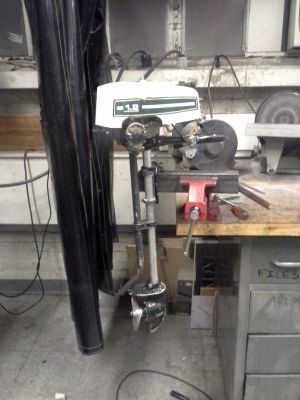 |
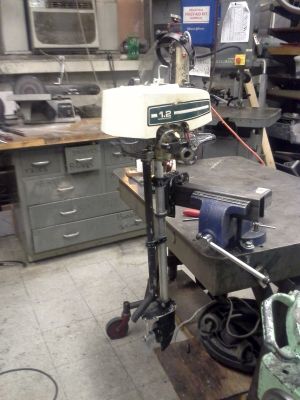 |
| Disassembly
time! The engine comes apart fairly easily, the top cover disappears and the whole engine can be removed with three flathead screws that mate the 'outboard' part and the engine itself |
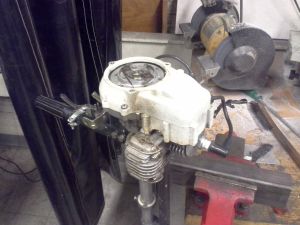 |
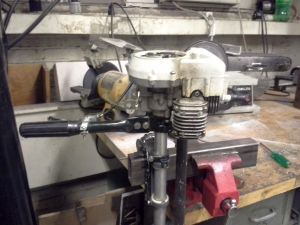 |
| Shown is the bottom of the engine with the three screw mount around the outboard shaft assembly. The outboard shaft itself mates to the engine with this odd shaft + pin loose coupling. I think this may help remove shock load from the engine but also allows for easier assembly in a factory environment . | 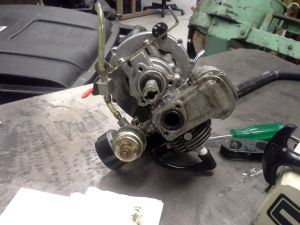 |
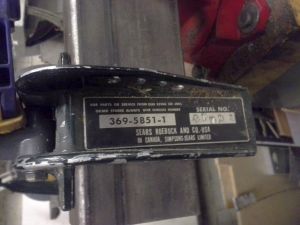 |
| With the outboard shaft an prop removed we begin electrification. Shown is the opposing mate to the outboard, inside the outboard assembly |
| The motor and adapter |
||
| Here's
the motor The older cousin to the 'Black Max' dc brush motor used in everything from floor scrubbers to combat robots, its a SCOTT MOTORS pump motor, rated at 28v 40A, or 1hp. Because its a pump motor it has a strange housing with an inset shaft. Pump assemblies apparently bolt directly to the motor. Admittedly this makes it a bit more difficult to use in shaft-driven-thing applications, but lathes are our friends and adapters can be fashioned |
||
| Lets
make an adapter Here's the front face of the motor, after some quick calipering and sketching an adapter was designed. Using three plates of 3/4" thick aluminum we'd capture a flanged bearing, and still be able to clamp onto the existing outboard base mount. |
||
| Off
to solidworks. The adapter is shown, and the design files [Solidworks 2014] are included below. Pack and Go Assembly [link] PDF of design file [link] DXF cut file [link] |
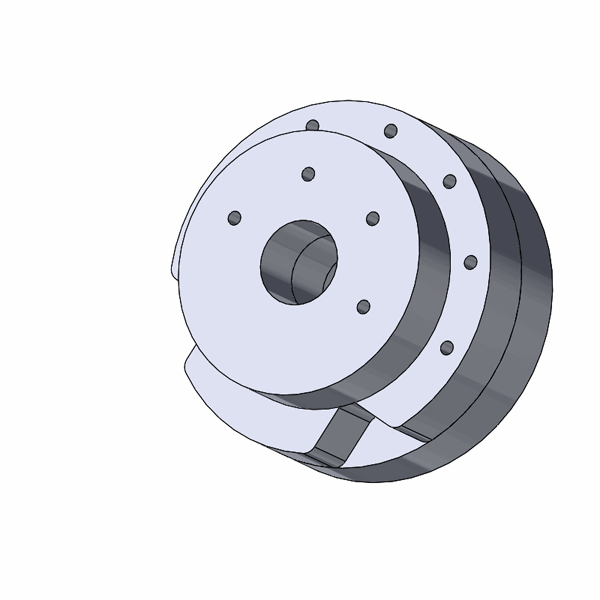 |
|
| Magical Waterjets The 3/4 inch thick stock itself was scrap that was leftover, the N52 jet had no trouble chewing through the relatively thick material. |
||
| And
the turning begins After some quick boring bar action, a flanged bearing slid right into place on the inner bearing mount. I used steel shaft, milled with a flat matching groove, to mate to the motor itself. This was used for positioning as well for the mating motor hardware. |
||
| Using a Bridgeport milling machine, inset holes were added for the socket head bolts, including space for the sockets. This captures the hardware used for the motor mount. As this is a vibrating environment medium loctite was used to help prevent decoupling of the motor and the mount. An opposing flanged bearing was added to keep the shaft co-linear with the surface. | ||
| Shaft
features the shaft itself started as a center-drilled hole with a slot added in to match the opposing feature inside of the outboard. The shaft diameter was turned to fit the flange bearings on hand, with the exception of the very top area which features a retaining ring to constrain the shaft to live inside the captured motor-adapter area. |
||
| All buttoned up, the motor-shaft adapter came together quickly, a small amount of spring steel-shim-stock was added in the motor inset groove to keep the assembly under tension while assembling. Note that the perimeter holes are tapped such that the next part (outboard shaft clamp) can mate to the motor. The mating holes are only on one side as the clamp applies pressure by use of a flexure. | ||
| The
flexure and the retaining ring bolt onto the motor directly. The two
parts are stacked to provide more surface area for the motor assembly
to mate to the outboard. I was mildly concerned that if one
section sat as the clamping surface it would kink or apply too much
force to the outboard. The length of the motor shaft was tailored to
the distance the internal outboard mate was. All in all it fit! |
| Bench Test-> ENDURANCE TEST |
||
| Excitedly the prop was shoved in a bucket and the motor was spooled up, splashing everywhere occurred. | ||
| Next up, Myself Birkel and Ciarian headed west to test the brand new contraption out on some fresh water. To power the craft we ended up using (effectively) a 12S LiFePO4 pack (40v nominal). This was controlled with a 200A DC circuit breaker switch, no motor controller was used otherwise. The boat is an 8' JON BOAT, aluminum extrusion which weighs about 60lbs and fits three folks if they get friendly. | ||
| So we let birkel test it out first and lo, it worked. Initial tests were at 8S LiFePO4 (28V), but looking at the in-line watt-meter we were only pulling 30A, i ran back and grabbed a 4S pack and hastily added it in series. With 40v we now had quite a bit more pep and we were off to do a stress-test. | 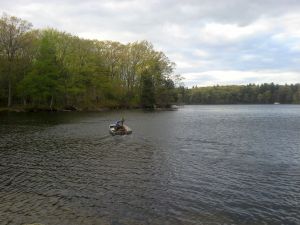 |
 |
| The Endurance Test Important to note, the craft had 3 people and a fairly large battery array onboard we were moving at roughly 6mph across the water, which was fairly excellent given how much surface area we were taking up in the water. The outboard held up well and got us to / from the island without too much hassle. |
(There's
other photos in the photo gallery)
Concluding Remarks:- Simple is sometimes dramatically undervalued, this thruster
has
been used so far on a number of outdoor adventures, and propelled
myself and comrades a total of 30 miles, the lack of a motor controller
results in some curious startup transients, but otherwise works well, a
shear pin located in the propeller housing prevents a stuck prop from
destroying the remaining mechanicals. So far this has worked incredibly
well and been a great 'plug in a 12S pack and go' assembly. Yes a
brush-less / three phase / submerged setup would be quieter or sexier
but there is something to be said for simple and functional.
| Comments: |
|
HTML Comment Box
is loading comments...
|
(be
careful, im not responsible for incredibly warm DC power cabling )
Dane.Kouttron
Rensselaer Polytechnic Institute
Electrical & Electrical Power
631.978.1650
